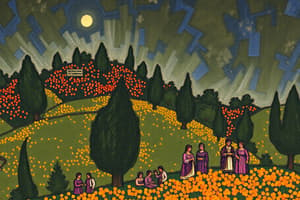Podcast
Questions and Answers
What are the 4 regions that occupy 2/3 of the world's inhabitants? (Select all that apply)
What are the 4 regions that occupy 2/3 of the world's inhabitants? (Select all that apply)
- Europe (correct)
- East Asia (correct)
- South Asia (correct)
- Southeast Asia (correct)
What is ecumene?
What is ecumene?
A portion of Earth's surface that is permanently occupied by human settlements.
What are the 4 lands that are sparsely populated on Earth?
What are the 4 lands that are sparsely populated on Earth?
Wet lands, Dry lands, High lands, Cold lands.
Define arithmetic density.
Define arithmetic density.
Define physiological density.
Define physiological density.
Define agricultural density.
Define agricultural density.
Define crude birth rate (CBR).
Define crude birth rate (CBR).
Define crude death rate (CDR).
Define crude death rate (CDR).
What is the current natural increase rate (NIR)?
What is the current natural increase rate (NIR)?
What is the current world population growth in terms of annual addition?
What is the current world population growth in terms of annual addition?
Define doubling time.
Define doubling time.
What does Total Fertility Rate (TFR) indicate?
What does Total Fertility Rate (TFR) indicate?
What is the global average TFR?
What is the global average TFR?
Define infant mortality rate (IMR).
Define infant mortality rate (IMR).
What is the definition of life expectancy?
What is the definition of life expectancy?
Define population pyramid.
Define population pyramid.
What is the dependency ratio?
What is the dependency ratio?
What is the sex ratio?
What is the sex ratio?
What types of countries are likely to have more males than females?
What types of countries are likely to have more males than females?
What is the difference between CBR and TFR, which is more accurate?
What is the difference between CBR and TFR, which is more accurate?
In which type of countries is CDR lower and why?
In which type of countries is CDR lower and why?
What is the Demographic Transition Model?
What is the Demographic Transition Model?
Describe Stage 1 of the Demographic Transition Model.
Describe Stage 1 of the Demographic Transition Model.
What is the influence of China and India on future prospects for global overpopulation?
What is the influence of China and India on future prospects for global overpopulation?
What are two ways to reduce birth rates?
What are two ways to reduce birth rates?
Study Notes
Population Distribution
- Four major regions occupy 2/3 of the world's population: East Asia, South Asia, Southeast Asia, and Europe.
Ecumene vs. Non-Ecumene
- Ecumene refers to areas of Earth's surface permanently settled by humans.
- Non-ecumene consists of areas not permanently inhabited due to harsh conditions unsuitable for agriculture.
Sparsely Populated Areas
- Sparsely populated regions include wet lands, dry lands, high lands, and cold lands.
Density Measurements
- Arithmetic Density: Total population divided by land area.
- Physiological Density: Population per unit of arable land.
- Agricultural Density: Ratio of arable land to the number of farmers, lower in developed countries due to advances in technology.
Population Metrics
- Crude Birth Rate (CBR): Number of live births per 1,000 people per year.
- Crude Death Rate (CDR): Number of deaths per 1,000 people per year.
- Net Increase Rate (NIR): Percentage of population growth in a year.
Current NIR Trends
- Current NIR stands at 1.2%, peaking in 1963 due to the baby boom.
- Annually, approximately 82 million people are added to the global population.
Doubling Time and Growth Regions
- Doubling time indicates years required to double a population.
- Most population growth occurs in developing countries.
Total Fertility Rate (TFR)
- Total Fertility Rate estimates the number of children a woman will have during her child-bearing years.
- Global average TFR is 2.5; sub-Saharan Africa has a TFR of 5, while Europe has a TFR of 2.
Infant Mortality Rate and Life Expectancy
- Infant Mortality Rate measures deaths of infants under one year per number of live births.
- Life Expectancy reflects the average expected lifespan based on current mortality levels; developed countries exhibit lower IMRs compared to developing nations.
Population Pyramid and Dependency Ratio
- Population Pyramid illustrates a country's population structure grouped into five-year cohorts.
- Dependency Ratio quantifies individuals too young (0-14) or too old (65+) to work.
Sex Ratio
- Defines the number of males for every 100 females in a population, often skewed in certain regions.
Male Dominance in Certain Countries
- Many Asian countries show a higher male population due to a cultural preference for male children and practices like selective abortions of female fetuses.
CBR vs. TFR
- TFR offers a precise average of total children a woman will bear, while CBR reflects live births per 1,000 of any population group, which can include non-reproductive individuals.
CDR Variances
- Crude Death Rate is lower in developing countries due to younger life expectancy while in developed nations, deaths are more evenly distributed across age groups.
Demographic Transition Model (DTM)
- DTM describes population changes over time, through five distinct stages from low growth (Stage 1) to negative growth (Stage 5).
Stages of the DTM
- Stage 1: Characterized by high birth and death rates, resulting in negligible population growth.
- Stage 2: High birth rates and declining death rates lead to significant population increases.
- Stage 3: Birth rates decline rapidly, dead rates also drop, resulting in lower growth rates.
- Stage 4: Modern states exhibit low birth and death rates with zero population growth.
- Stage 5: Features very low birth rates alongside low death rates, indicating potential population decline.
Influence of China and India
- Together, China and India account for one-third of global population; differing family planning initiatives impact growth.
- India is projected to surpass China by 2030 due to higher annual increases of approximately 12 million.
Reducing Birth Rates
- Two effective strategies for lowering birth rates include improving education and healthcare access for women.
Studying That Suits You
Use AI to generate personalized quizzes and flashcards to suit your learning preferences.
Description
Explore key concepts from AP Human Geography Chapter 2 related to population density and distribution. This quiz focuses on understanding the four major population regions and terms like ecumene and non-ecumene. Test your knowledge and enhance your understanding of human geography!




